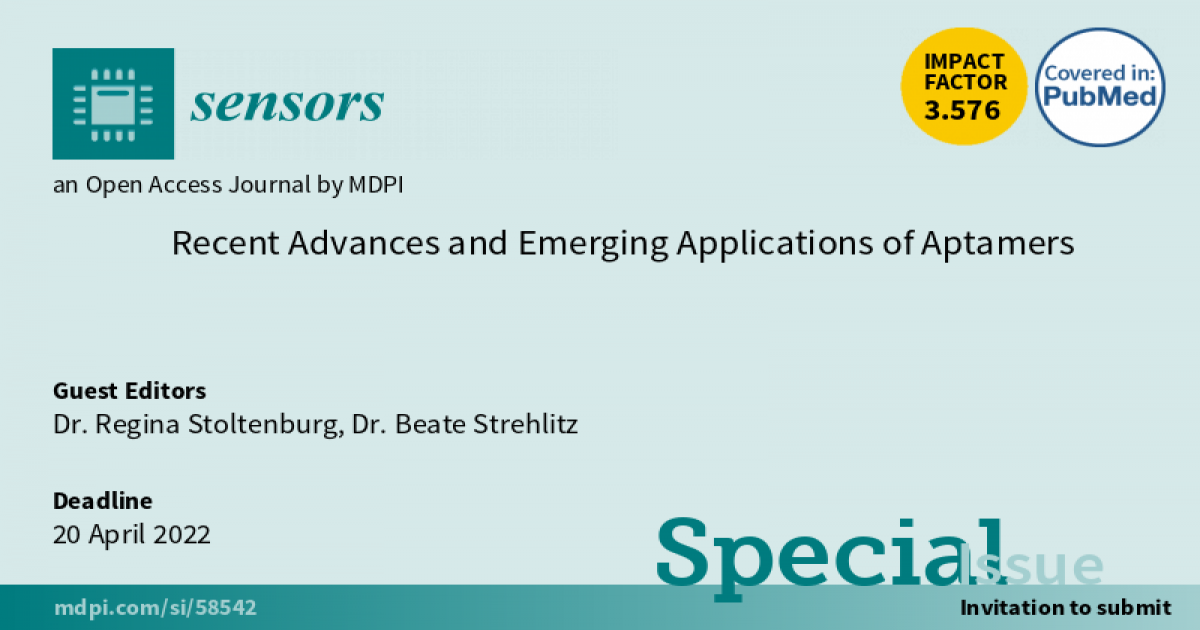Recent Advances and Emerging Applications of Aptamers
A special issue of Sensors (ISSN 1424-8220). This special issue belongs to the section "Biosensors".
Deadline for manuscript submissions: closed (20 April 2022) | Viewed by 3966

Special Issue Editors
Interests: aptamer selection and characterization; SELEX; aptamer applications; aptamer-based assays; aptasensors; ELONA; SPR; G-quadruplexes; microbiology; NGS; microbial communities; microbial ecology; yeasts
Special Issues, Collections and Topics in MDPI journals
Interests: aptamer selection and characterization; SELEX; aptamer based sensors and assays; biosensor development and application; bioelectrotechnology; bioelectrochemistry
Special Issues, Collections and Topics in MDPI journals
Special Issue Information
Dear Colleagues,
Aptamers have become a highly promising class of targeting molecules, and have attracted the attention of many scientists in various research areas. Aptamers are known as a special kind of functional nucleic acids, that are able to recognize and bind their target molecules with high affinity and specificity. They are usually selected using an evolutionary method called SELEX. This technology has been extensively modified and optimized over the years and significantly expanded by computational approaches and new sequencing technologies.
The portfolio of aptamers for specific targets (from small molecules over proteins to complex target structures) is increasingly growing. The varied application possibilities of aptamers include areas such as basic research, health (medicine/pharmacy), environmental monitoring or food industry. Aptamers have a very promising potential as theragnostic agents, delivery agents, molecular imaging tools, and as capture or reporter molecules. They have been successfully verified as molecular recognition elements in a wide range of analytical systems, using different detection principles (e.g., electrochemical, optical, acoustic or mass-sensitive methods, colorimetric approaches, fluorescence-based or SPR-based methods). New technologies like nanotechnologies and recent advances in materials sciences and sensor designs support the development of new aptasensors and aptamer-based detection assays.
This Special Issue of Sensors will cover recent advances and emerging applications of aptamers. We welcome submissions that expand the exciting world of aptamers by the presentation of new aptamers and new methods for their selection, by opening up new fields of application, describing new aptasensor designs, or by developing powerful aptamer-based assays.
Research papers and review articles will be considered. We look forward to and welcome your participation in this Special Issue.
Dr. Regina Stoltenburg
Dr. Beate Strehlitz
Guest Editors
Manuscript Submission Information
Manuscripts should be submitted online at www.mdpi.com by registering and logging in to this website. Once you are registered, click here to go to the submission form. Manuscripts can be submitted until the deadline. All submissions that pass pre-check are peer-reviewed. Accepted papers will be published continuously in the journal (as soon as accepted) and will be listed together on the special issue website. Research articles, review articles as well as short communications are invited. For planned papers, a title and short abstract (about 100 words) can be sent to the Editorial Office for announcement on this website.
Submitted manuscripts should not have been published previously, nor be under consideration for publication elsewhere (except conference proceedings papers). All manuscripts are thoroughly refereed through a single-blind peer-review process. A guide for authors and other relevant information for submission of manuscripts is available on the Instructions for Authors page. Sensors is an international peer-reviewed open access semimonthly journal published by MDPI.
Please visit the Instructions for Authors page before submitting a manuscript. The Article Processing Charge (APC) for publication in this open access journal is 2600 CHF (Swiss Francs). Submitted papers should be well formatted and use good English. Authors may use MDPI's English editing service prior to publication or during author revisions.
Keywords
- aptamers
- affinity molecules
- biomolecular interactions
- aptasensors
- aptamer-based assays
- clinical diagnostics
- environmental analysis
- food analysis
- water analytics
- SELEX
Benefits of Publishing in a Special Issue
- Ease of navigation: Grouping papers by topic helps scholars navigate broad scope journals more efficiently.
- Greater discoverability: Special Issues support the reach and impact of scientific research. Articles in Special Issues are more discoverable and cited more frequently.
- Expansion of research network: Special Issues facilitate connections among authors, fostering scientific collaborations.
- External promotion: Articles in Special Issues are often promoted through the journal's social media, increasing their visibility.
- e-Book format: Special Issues with more than 10 articles can be published as dedicated e-books, ensuring wide and rapid dissemination.
Further information on MDPI's Special Issue policies can be found here.







